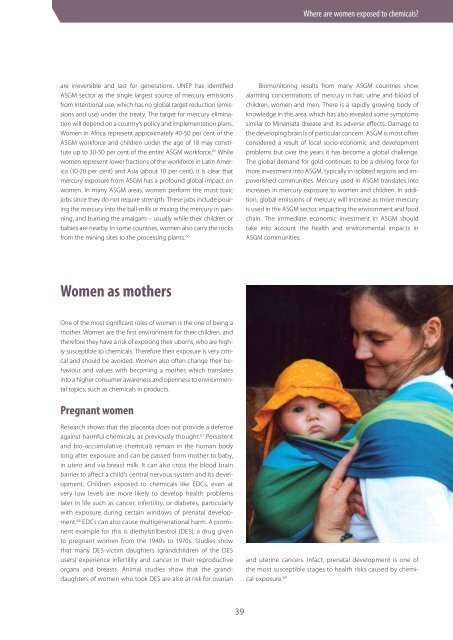Women and Chemicals
1ToENNR
1ToENNR
Create successful ePaper yourself
Turn your PDF publications into a flip-book with our unique Google optimized e-Paper software.
Where are women exposed to chemicals?<br />
are irreversible <strong>and</strong> last for generations. UNEP has identified<br />
ASGM sector as the single largest source of mercury emissions<br />
from intentional use, which has no global target reduction (emissions<br />
<strong>and</strong> use) under the treaty. The target for mercury elimination<br />
will depend on a country‘s policy <strong>and</strong> implementation plans.<br />
<strong>Women</strong> in Africa represent approximately 40-50 per cent of the<br />
ASGM workforce <strong>and</strong> children under the age of 18 may constitute<br />
up to 30-50 per cent of the entire ASGM workforce. 65 While<br />
women represent lower fractions of the workforce in Latin America<br />
(10-20 per cent) <strong>and</strong> Asia (about 10 per cent), it is clear that<br />
mercury exposure from ASGM has a profound global impact on<br />
women. In many ASGM areas, women perform the most toxic<br />
jobs since they do not require strength. These jobs include pouring<br />
the mercury into the ball-mills or mixing the mercury in panning,<br />
<strong>and</strong> burning the amalgam – usually while their children or<br />
babies are nearby. In some countries, women also carry the rocks<br />
from the mining sites to the processing plants. 66<br />
Biomonitoring results from many ASGM countries show<br />
alarming concentrations of mercury in hair, urine <strong>and</strong> blood of<br />
children, women <strong>and</strong> men. There is a rapidly growing body of<br />
knowledge in this area, which has also revealed some symptoms<br />
similar to Minamata disease <strong>and</strong> its adverse effects. Damage to<br />
the developing brain is of particular concern. ASGM is most often<br />
considered a result of local socio-economic <strong>and</strong> development<br />
problems but over the years it has become a global challenge.<br />
The global dem<strong>and</strong> for gold continues to be a driving force for<br />
more investment into ASGM, typically in isolated regions <strong>and</strong> impoverished<br />
communities. Mercury used in ASGM translates into<br />
increases in mercury exposure to women <strong>and</strong> children. In addition,<br />
global emissions of mercury will increase as more mercury<br />
is used in the ASGM sector, impacting the environment <strong>and</strong> food<br />
chain. The immediate economic investment in ASGM should<br />
take into account the health <strong>and</strong> environmental impacts in<br />
ASGM communities.<br />
<strong>Women</strong> as mothers<br />
One of the most significant roles of women is the one of being a<br />
mother. <strong>Women</strong> are the first environment for their children, <strong>and</strong><br />
therefore they have a risk of exposing their uborns, who are highly<br />
susceptible to chemicals. Therefore their exposure is very critical<br />
<strong>and</strong> should be avoided. <strong>Women</strong> also often change their behaviour<br />
<strong>and</strong> values with becoming a mother, which translates<br />
into a higher consumer awareness <strong>and</strong> openness to environmental<br />
topics, such as chemicals in products.<br />
Pregnant women<br />
Research shows that the placenta does not provide a defense<br />
against harmful chemicals, as previously thought. 67 Persistent<br />
<strong>and</strong> bio-accumulative chemicals remain in the human body<br />
long after exposure <strong>and</strong> can be passed from mother to baby,<br />
in utero <strong>and</strong> via breast milk. It can also cross the blood brain<br />
barrier to affect a child’s central nervous system <strong>and</strong> its development.<br />
Children exposed to chemicals like EDCs, even at<br />
very low levels are more likely to develop health problems<br />
later in life such as cancer, infertility, or diabetes, particularly<br />
with exposure during certain windows of prenatal development.<br />
68 EDCs can also cause multigenerational harm. A prominent<br />
example for this is diethylstilbestrol (DES), a drug given<br />
to pregnant women from the 1940s to 1970s. Studies show<br />
that many DES-victim daughters (gr<strong>and</strong>children of the DES<br />
users) experience infertility <strong>and</strong> cancer in their reproductive<br />
organs <strong>and</strong> breasts. Animal studies show that the gr<strong>and</strong>daughters<br />
of women who took DES are also at risk for ovarian<br />
<strong>and</strong> uterine cancers. Infact, prenatal development is one of<br />
the most susceptible stages to health risks caused by chemical<br />
exposure. 69<br />
39


